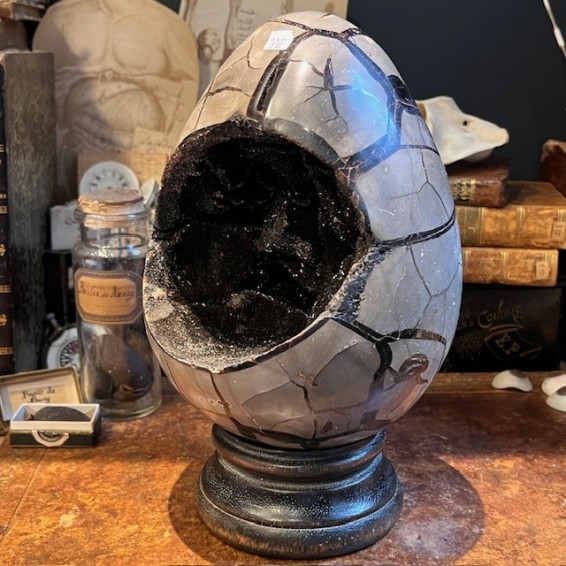
Display for ball or ostrich egg (Large)
High base specially designed to hold a ball or egg
Perfect for ostrich eggs
Not suitable for emu, rhea or swan eggs, for example









Dragon Stone
Septaria egg of Madagascar
Septaria Madagascar egg
Also known as Dragon Stone
Septaria is a stone composed of a mixture of yellow calcite and sandstone, found mainly on the island of Madagascar, characterized by highly visible shrinkage cracks. These highly visible cracks, known as Septa, fill with minerals over time.
When the stone is polished, these cracks stand out, giving it a dragon's egg appearance on the outside.
With time, tectonic movements, etc., the nodules can be fractured and new mineral solutions can invade the shrinkage cracks, often calcite.
In our case, Septaria has been polished into an egg shape and the interior has been invaded by a very fine crystallization of calcite. Beautiful crystals.
It's also easy to see why it's called Dragon's Stone: the exterior is very similar to a dragon's egg!
Sold without base
Ref OSM52: Weight: 5kg - Height: 19/20cm
Sold without the base
You can find available bases by typing ball base or egg base in the site search.
High base specially designed to hold a ball or egg
Perfect for ostrich eggs
Not suitable for emu, rhea or swan eggs, for example
Wooden base for ball or sphere - Base - support
Grey-Black patinated marble base for ball or sphere
Base - support
Antique surgical board
From Benjamin Bell's Complete Course in Surgery, published in 1796
Red chalk drawing- Anatomical drawing
Anatomical study
Drawn by Eugène de Montchoisy in Saint-Brieuc in November 1840
These are not reproductions but original period drawings in red chalk.
You are purchasing one plate, not the entire set of plates
Entomological frame - Scarab Goliathus meleagris female with spread wings
Dragon Stone
Septaria egg of Madagascar
Antique study mask by Simonne Laubé, circa 1930
Flayed model
In vulcanized and painted rubber
Inspired by the famous death mask from L'Inconnue de la Seine
Natural Red Coral
Tubipora Musica
Sold with a CITES permit valid for the European Union - Schengen area
Cannot be sold outside the European Union
Double skeleton
Sculpture on deer antlers
Unique piece
Australian saltwater crocodile skull: Crocodylus porosus
Estuary crocodile
With its CITES permit
31cm
Can only be sold in the European Union- Shengen Area
Antique surgical board
From Benjamin Bell's Complete Course in Surgery, published in 1796
Manuel d'Anatomie descriptive du corps humain - Atlas
Anatomical Atlas - Manual of Descriptive Anatomy of the Human Body
In quarto
By Dr Cloquet - 1831 - IN COLOUR - Volume III only
Atlas consisting of 172 lithographed plates, most in colour
Binding very damaged, the leather has been torn from the boards, the first few leaves are fragile, even loose, but the rest is in good condition, the plates are very beautiful. see photos.
Attention this is Volume 2 of the Atlas, there are no plates from Volume 1 of the Atlas. The title pages at the beginning of the book are missing.
Engraved horse skull
Papuan handicraft
Origin: West Papua
Cours d'opérations de chirurgie, démontrées au Jardin Royal
Course of surgical operations, demonstrated in the Royal Garden
Published in 1751 in Paris, by d'Houry, sole printer and bookseller to Monseigneur le Duc d'Orléans
Fourth edition
Illustrated with numerous plates and engravings in the text, including the famous plate of Poor Malabou and her scrotal elephantiasis on page 112/113, which the author mentions on page 373.
Antique bezoar - Antipoison - Antidote
Once sold by the apothecary, bezoar, also known as gallstone, was reputed to have the same anti-poison properties as the legendary unicorn's horn, hence its excessively high price, also due to its great rarity.
An important piece in a cabinet of curiosities
Sold alone - Without stand, sold separately
European lobster - Beauchêne explosion style under glass
Homarus gammarus
By Will Never Die
Available in shop only - No shipping
Australian saltwater crocodile skull: Crocodylus porosus
Estuary crocodile
With its CITES permit
32cm
Can only be sold in the European Union- Shengen Area

Dragon Stone
Septaria egg of Madagascar









